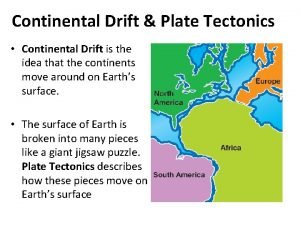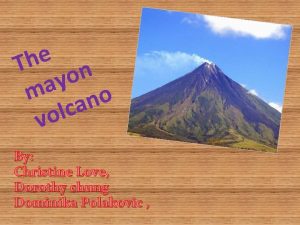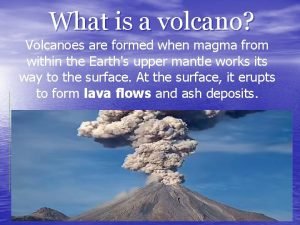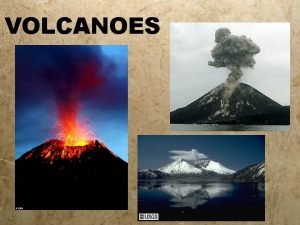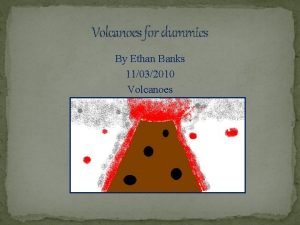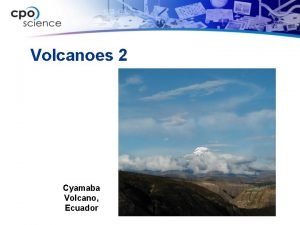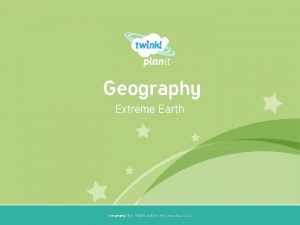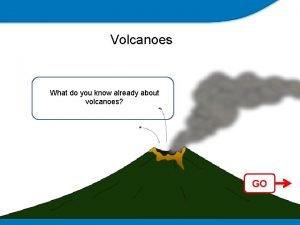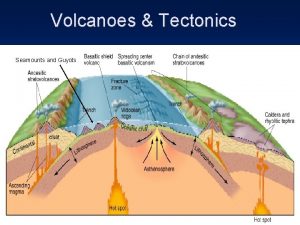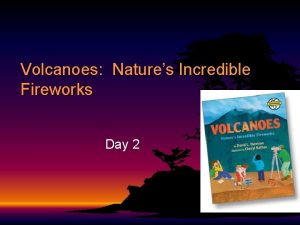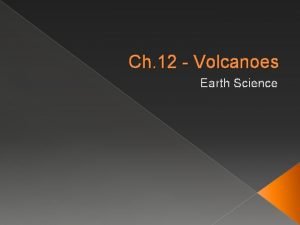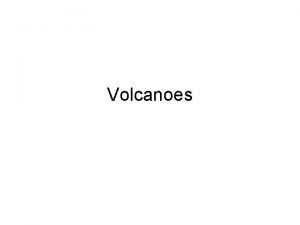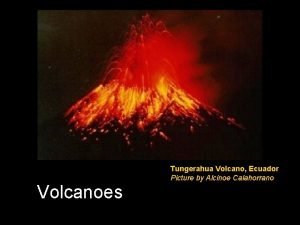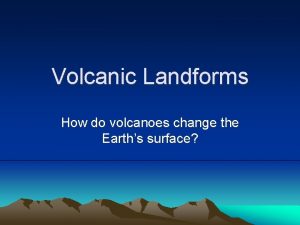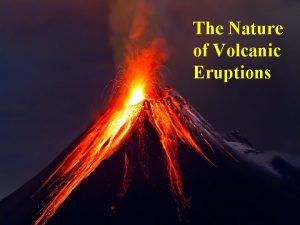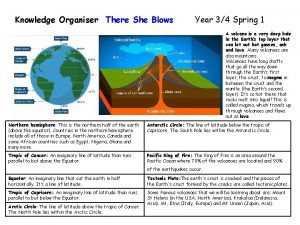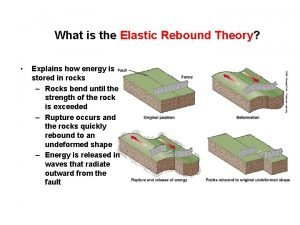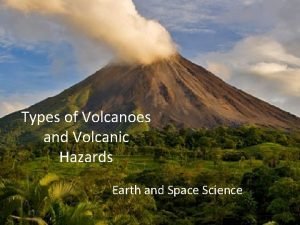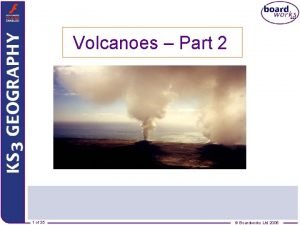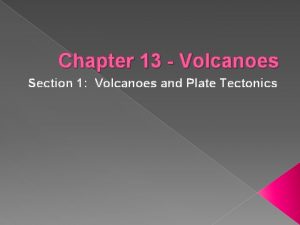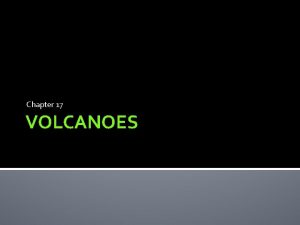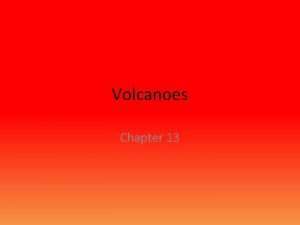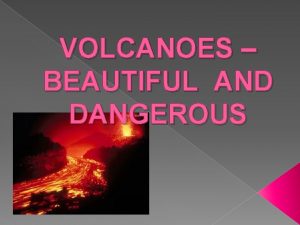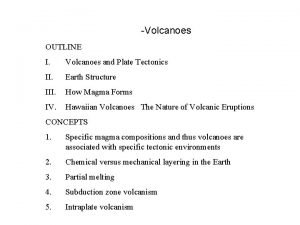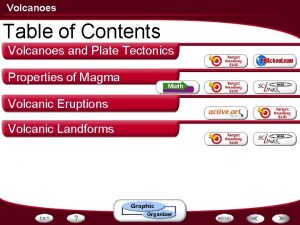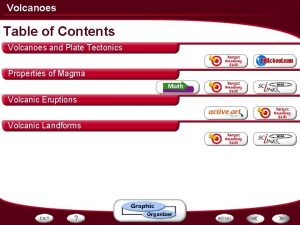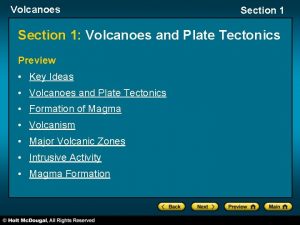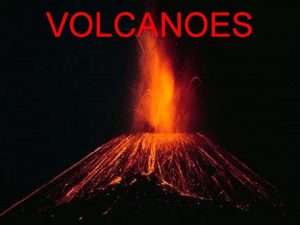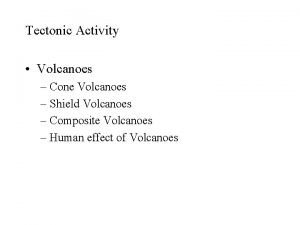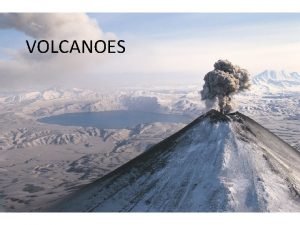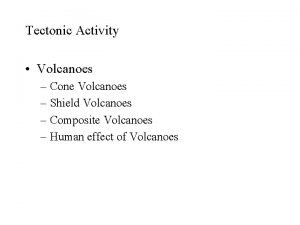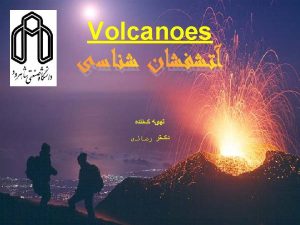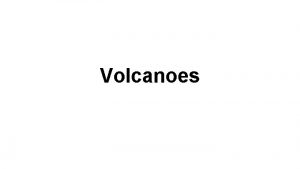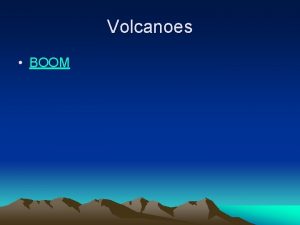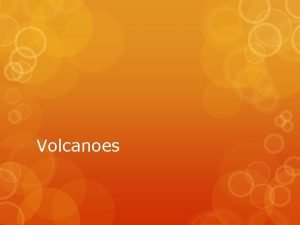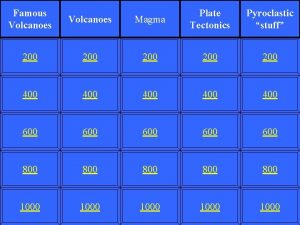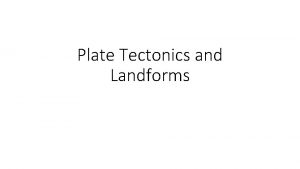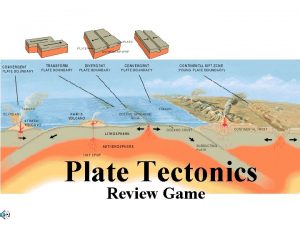Chapter 5 Volcanoes 5 1 Volcanoes and Plate


























- Slides: 26

Chapter 5: Volcanoes 5. 1 Volcanoes and Plate Tectonics

Volcanoes �Volcano: mountain that forms in Earth’s crust when molten material (magma) reaches the surface. �Remember, magma is molten rock below ground; lava is molten rock at the surface.

Volcanoes �Volcanoes form along plate boundaries. At divergent boundaries, the crust cracks and allows molten rock to rise (mid-ocean ridge). At convergent boundaries, one plate can sink beneath the other, which helps bring magma to the surface (on ocean floor).

Island Arc �An island arc is a string of islands formed from volcanoes. �Some common ones are Japan, New Zealand, the Aleutians, and the Caribbean islands. �Some continental volcanoes include Mount St. Helens and Mount Rainier.

Hot Spots �Some volcanoes form from hot spots: an area where material from the mantle rises through the crust. �Hot spots are stationary beneath the crust, and the plates move over them.

Chapter 5: Volcanoes 5. 2 Volcanic Eruptions

Volcanic Structure �Magma chamber: pocket of magma beneath the volcano. �Pipe: connects the magma chamber to Earth’s surface. �Vent: the area where molten rock and has leave the volcano. �Lava flow: the spread of lava as it leaves the vent �Crater: bowl-shaped area around the central vent.

Volcanic Structure

Volcanic Eruption �Dissolved gases are built up in magma. �As they expand, pressure increases, and eventually forces the magma through the pipe and out of the vent.

Volcanic Eruption �Eruptions can be quiet or explosive; it depends on the magma’s silica content and the thickness of the magma.

Volcanic Eruptions �If magma is very hot and low in silica, the volcano erupts quietly. Lava can flow for long periods of time; built the Hawaiian islands. �Magma that is high in silica explodes from a volcano. Mount St. Helens in Washington erupts this way.

Rock Fragments �Volcanic Ash: Consists of particles ranging from the size of dust to the size of rice grains �Volcanic Cinders �Volcanic Bombs �Volcanic Blocks: Solid pieces of rock, as big as houses

Volcano Hazards �Quiet eruptions have large lava flows and burn and bury almost everything in its path. �Explosive eruptions release dangerous materials that form clouds around the volcano. Pyroclastic flow: mixture of hot gases, ash, cinders, and bombs that rush down a volcano.

Volcano Activity �An active volcano is one currently erupting or showing signs of erupting soon. �A dormant volcano is one that is “sleeping” but expected to turn active in the future. �An extinct volcano is one that is unlikely to ever erupt again.

Predicting Activity �Geologists use tiltmeters to measure small changes in the ground caused by magma movement. �They also monitor earthquakes, which can cause volcanic eruptions. �They measure gas from the volcano, and also keep track of temperatures.

Chapter 5: Volcanoes 5. 3 Volcanic Landforms

Calderas �A caldera is a hole left behind when a volcano collapses. �Lakes may form in this hole over time. �Usually associated with shield and composite volcanoes.

Cinder Cone Volcanoes �A steep, cone-shaped hill or small mountain �Formed by ash, cinders, and bombs building up around the volcano’s vent. �Usually magma high in silica

Composite Volcanoes �Tall, cone-shaped mountains with layers of lava and ash �Usually alternates between quiet and explosive

Shield Volcanoes �Wide, gently sloping mountain �Thin layers of lava pour out of a vent and cool in layers. �Hot spot volcanoes are usually this type.

The largest volcano on Earth, Mauna Loa.

Lava Plateaus �Lava plateaus are made from thin, runny lava floods that cool and solidify.

Magma Landforms �Volcanic neck: forms when magma hardens in a volcano’s pipe and the rock wears away.

Magma Landforms �Dike: magma that moves across rock layers �Sill: magma that squeezes between rock layers

Magma Landforms �Batholith: mass of rock formed when a large body of magma cools inside the crust.

Magma Landforms �Dome Mountains: bodies of hardened magma that are pushed upward toward the surface.
 Chapter 8 earthquakes and volcanoes
Chapter 8 earthquakes and volcanoes Spread plate vs pour plate
Spread plate vs pour plate Convergent plate boundary
Convergent plate boundary Isolation of pure cultures
Isolation of pure cultures Chapter 6 microbial nutrition and growth
Chapter 6 microbial nutrition and growth 7 lithospheric plates
7 lithospheric plates Interesting facts about mt mayon
Interesting facts about mt mayon Constructive forces examples
Constructive forces examples Describe volcano
Describe volcano How are volcanoes classified
How are volcanoes classified Volcanoes for dummies
Volcanoes for dummies N
N Extreme earth
Extreme earth What do you already know about volcanoes
What do you already know about volcanoes Three main ways volcanoes are created
Three main ways volcanoes are created Volcanoes nature's incredible fireworks
Volcanoes nature's incredible fireworks Types of volcanoes
Types of volcanoes How are volcanoes formed
How are volcanoes formed Volcanic belts form along _____.
Volcanic belts form along _____. Active volcanoes map
Active volcanoes map Krakatoa volcano
Krakatoa volcano Magma
Magma Volcanoes knowledge organiser
Volcanoes knowledge organiser Rebound theory
Rebound theory Types of volcanoes
Types of volcanoes Ring of fire volcanoes
Ring of fire volcanoes Types of volcanoes according to shape
Types of volcanoes according to shape





